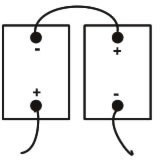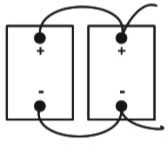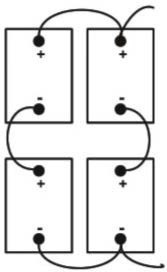How to increase capacity or voltage in your lead-acid battery system. Series, Parallel, and Series Parallel Connections.
The capacity of your single battery cannot be increased from its original capacity. However, strings of batteries can be easily connected together to increase a battery banks voltage or its capacity.
DO NOT CLOSE THE CIRCUIT BY CONNECTING THE LAST NEGATIVE TO THE FIRST POSITIVE WHEN MAKING PARALLEL OR SERIES PARALLEL CONNECTIONS.
Series Connection
To increase the VOLTAGE, you must connect multiple batteries in Series. Batteries are connected from terminal to terminal, with one battery's positive terminal connecting to the next battery's negative terminal.
Why are batteries connected in Series?
Connecting batteries in series multiplies the voltage but keep the capacity in Reserve Capacity (RC) or Ampere hour (Ah) the same. However, the total available energy in watt-hour (Wh) will also increase because there are more total energy reservoirs now in the system.
Figure 3 - Series Connections to increase VOLTAGE

Why connecting different capacity batteries in series should never be done!
Connecting batteries of the same voltage but with different capacities is not recommended. Different capacity batteries will have internal resistance differences, which translates into slight voltage differences, which means the batteries with higher voltage potential will try to charge the battery with lower voltage potential, leading to the lower potential battery being overcharged.
Never connect different capacity batteries in series. The lower-capacity battery will charge first, and the larger-capacity battery will remain under-charged. The lower-capacity battery will overcharge and can overheat. During discharge, the smaller battery will be over-discharged.
Parallel Connection
To increase a battery bank's CAPACITY (amp hours, reserve capacity), connect multiple batteries in Parallel.
Why are batteries connected in parallel?
Connecting batteries in parallel keep the voltage of the whole pack the same but multiplies the storage capacity and energy in Reserve Capacity (RC) or Ampere hour (Ah) and Watt hour (Wh). Paralleling batteries of the same voltage increases your available energy by adding more energy reservoirs.
Figure 4 - Parallel Connections

Why connecting different capacity batteries in parallel is not recommended!
Connecting batteries of the same voltage but with different capacities is not recommended. Different capacity batteries will have internal resistance differences, which translates into slight voltage differences. The batteries with higher voltage potential will try to charge the battery with lower voltage potential, leading to the lower potential battery being overcharged.
Series and Parallel Connection
Connect multiple batteries in Series and Parallel to increase the battery banks' VOLTAGE and CAPACITY. Batteries are connected from terminal to terminal, with one battery's positive terminal connecting to the next battery's positive terminal. All batteries must be of the same voltage. All batteries should be of the same capacity and age. DO NOT CLOSE THE CIRCUIT BY CONNECTING THE LAST NEGATIVE TO THE FIRST POSITIVE!
Figure 5 - Series/Parallel Connection for inexperienced installers

If more capacity is required, as mentioned above, multiple batteries can be connected in Parallel (the positive terminal of Battery One to the positive terminal of Battery Two and so on). Only use new and identical batteries. If you connect two 12-volt batteries in parallel and are identical in type, age and capacity, you can potentially double your original capacity. If you connect two that are not the same type, you will either overcharge the smaller of the two or you will undercharge the larger of the two. If you connect two identical, but one is older, you will reduce the life of the new one. When connecting in series or parallel and to prevent recharging problems, do not mix old and new batteries or ones of different chemistries or performance abilities. Cable lengths should be kept short, and cabling must be sized large enough to prevent significant voltage drops. There should be a maximum drop of 0.2 volts (200 milli-volts) between batteries. Many manufacturers restrict you from connecting more than four batteries in parallel.
Connecting batteries in Parallel for experienced INSTALLERS
It is possible to have more strings in parallel without reducing the battery life or the batteries getting out of balance. General conditions and features that apply for up to 10 strings in parallel are:
- The same voltage drops must be realized from each string to the end connection (load and ground) regardless if the string consists of one unit (single 2V cells or 6V and 12V monobloc) or several units. This can be achieved by properly choosing cable lengths, cable diameters and arrangement for crosswise connection configurations.
- The connector cables for each battery string's positive and negative terminals must have the same length.
- The minimum cable size for the end connectors of a string is 25mm²/100 Ah of string capacity.
- The end-connector cables must be placed on a copper bar with at least 100mm²/100 Ah of string capacity with the shortest possible distance.
- Each string MUST be isolatable with its own circuit breaker.
- The strings must have the same number of cells.
- Each string must be exposed to the same heat or temperature potential.
If these requirements are fulfilled, paralleling up to 10 strings is possible. The performance data of all the batteries must be applied to each string's end terminal. By using this parallel string configuration, the system's reliability is increased due to redundancy. Neither battery life nor reliability will be affected if this paralleling is done correctly. Parallel connection of strings with different capacities and ages is possible (the age and capacity of the batteries within each string MUST be the same). The current during both discharge and charge will be split according to the capacity or age of the batteries, respectively. Also, the type of lead-acid batteries may differ as long as the required charging regime and voltage (Vpc) per string are guaranteed. Always connect the individual series strings first and check that the different strings are at the same potential before connecting them.
